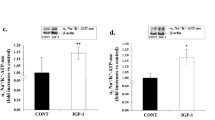Summary
3-hydroxy-3-methylgulutaryl-coenzyme A (HMG-CoA) reductase inhibitors or statins are a kind of lipid-lowering agents and have been used for the prevention and treatment of cardiovascular diseases. Recent studies suggested that statins, besides lowering cholesterol, may protect vessels by enhancing the activity of endothelial nitric oxide synthase (eNOS). In the present study, we investigated if simvastatin increases eNOS activity through its phosphorylation in 293 cells (293-eNOS) with stable expression of eNOS. The results showed that incubation of 293-eNOS cells with simvastatin (10 μm/L) for 2 h significantly increased in the activity of eNOS as shown by the conversion of L-arginine to L-citrulline (2889.70±201.51 versus 5630.18±218.75 pmol/min · mg proteins) (P<0.01). Western blotting revealed that simvastatin increased phosphorylation of eNOS at 1177 (ser) and also 495 (thr) but did not affect the overall expression of eNOS or inducible NOS. Further study found that simvastatin raised phosphorylation levels of Akt and AMPK, and such effect could be antagonized by Akt inhibitor or AMPK inhibitor. These results suggest that simvastatin could stimulate the activity of eNOS via its phosphorylation by Akt and AMPK, which provides a new mechanism, other than lipid-lowering effect, for the cardiovascular protection of statins.
Similar content being viewed by others
References
Randriamboavonjy V, Fleming I. Endothelial nitric oxide synthase (eNOS) in platelets: how is it regulated and what is it doing there? Pharmacol Rep, 2005,57(Suppl):59–65
Feron O, Balligand JL. Caveolins and the regulation of endothelial nitric oxide synthase in the heart. Cardiovasc Res, 2006,69(4):788–797
Forstermann U, Munzel T. Endothelial nitric oxide synthase in vascular disease: from marvel to menace. Circulation, 2006,113(13):1708–1714
Yang Z, Ming XF. Recent advances in understanding endothelial dysfunction in atherosclerosis. Clin Med Res, 2006,4(1):53–65
Urbich C, Dimmeler S. Risk factors for coronary artery disease, circulating endothelial progenitor cells, and the role of HMG-CoA reductase inhibitors. Kidney Int, 2005,67(5):1672–1676
Wang H, Lin L, JIANG J, et al. Up-regulation of endothelial nitric-oxide synthase by endothelium-derived hyperpolarizing factor involves mitogen-activated protein kinase and protein kinase C signaling pathways. J Pharmacol Exp Ther, 2003,307(2):753–764
Maron DJ, Fazio S, Linton MF. Current perspective on statins. Circulation, 2000,101(2):207–213
Paciaroni M, Hennerici M, Agnelli G, et al. Statins and stroke prevention. Cerebrovasc Dis, 2007,24(2–3):170–182
Yamada T, Node K, Mine T, et al. Long-term effect of atorvastatin on neurohumoral activation and cardiac function in patients with chronic heart failure: A prospective randomized controlled study. Am Heart J, 2007,153(6): 1055.e1–8
Laufs U, Custodis F, Böhm M. HMG-CoA reductase inhibitors in chronic heart failure: potential mechanisms of benefit and risk. Drugs, 2006,66(2):145–154
Martin JH, Krum H. Statins and clinical outcomes in heart failure. Clin Sci (Lond), 2007,113(3):119–127
Lefer AM, Campbell B, Shin YK, et al. Simvastatin preserves the ischemic-reperfused myocardium in normocholesterolemic rat hearts. Circulation, 1999,100(2):178–184
Abraham SS, Osorio JC, Homma S, et al. Simvastatin preserves cardiac function in genetically determined cardiomyopathy. J Cardiovasc Pharmacol, 2004,43(3):454–461
Kureishi Y, Luo Z, Shiojima I, et al. The HMG-CoA reductase inhibitor simvastatin activates the protein kinase Akt and promotes angiogenesis in normocholesterolemic animals. Nat Med, 2000,6(8):1004–1010
Di Napoli P, Taccardi AA, Grilli A, et al. Chronic treatment with rosuvastatin modulates nitric oxide synthase expression and reduces ischemia-reperfusion injury in rat hearts. Cardiovasc Res, 2005,66(3):462–471
Cooke JP. NO and angiogenesis. Atheroscler Suppl, 2003,4(4):53–60
Kalinowski L, Dobrucki LW, Brovkovych V, et al. Increased nitric oxide bioavailability in endothelial cells contributes to the pleiotropic effect of cerivastatin. Circulation, 2002,105(8):933–938
Laufs U, Liao JK. Post-transcriptional regulation of endothelial nitric oxide synthase mRNA stability by Rho GTPase. J Biol Chem, 1998,273(37):24 266–24 271
Rikitake Y, Liao JK. Rho GTPases, statins, and nitric oxide. Circ Res, 2005,97(12):1232–1235
Essig M, Nguyen G, Prie D, et al. 3-Hydroxy-3-methylglutaryl coenzyme A reductase inhibitors increase fibrinolytic activity in rat aortic endothelial cells: Role of geranylgeranylation and Rho proteins. Circ Res, 1998, 83(7):683–690
Laufs U, Marra D, Node K, et al. 3-Hydroxy-3-methylglutaryl-CoA reductase inhibitors attenuate vascular smooth muscle proliferation by preventing rho GTPase-induced down-regulation of p27(Kip1). J Biol Chem, 1999,274(31):21 926–21 931
Xia Y, Dawson VL, Dawson TM, et al. Nitric oxide synthase generates superoxide and nitric oxide in arginine-depleted cells leading to peroxynitrite-mediated cellular injury. PNAS, 1996,93(13):6770–6774
Ramasamy S, Parthasarathyb S, Harrison DG. Regulation of endothelial nitric oxide synthase gene expression by oxidized linoleic acid. J Lipid Res, 1998,89:268–276
Boo YC, Sorescu G, Boyd N, et al. Shear stress stimulates phosphorylation of endothelial nitric-oxide synthase at ser1179 by akt-independent mechanisms. Role of protein kinase A. J Biol Chem, 2002,277(5):3388–3396
Harris MB, Ju H, Venema VJ, et al. Reciprocal phosphorylation and regulation of endothelial nitric-oxide synthase in response to bradykinin stimulation. J Biol Chem, 2001,276(19):16 587–16 591
Author information
Authors and Affiliations
Additional information
Xiaoxia LI and Peihua WANG contributed equally to this work.
This project was supported by grants from National Natural Sciences Foundation of China (No. 30430320 and 30770882) and National 973 Project (No. 2007CB512004).
Rights and permissions
About this article
Cite this article
Li, X., Wang, P., Xu, X. et al. Simvastatin increases the activity of endothelial nitric oxide synthase via enhancing phosphorylation. J. Huazhong Univ. Sci. Technol. [Med. Sci.] 29, 286–290 (2009). https://doi.org/10.1007/s11596-009-0304-0
Received:
Published:
Issue Date:
DOI: https://doi.org/10.1007/s11596-009-0304-0




